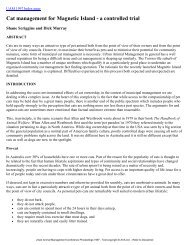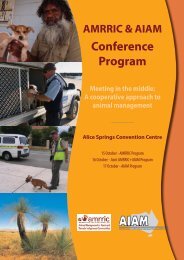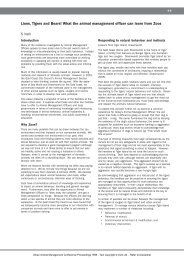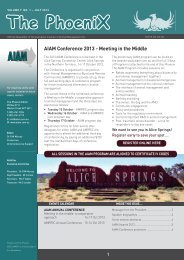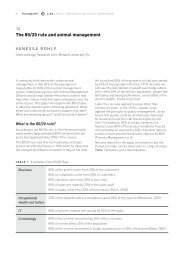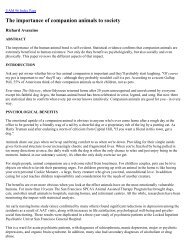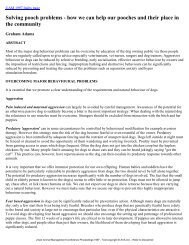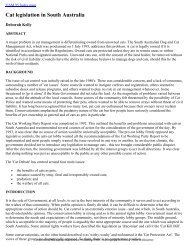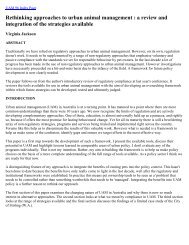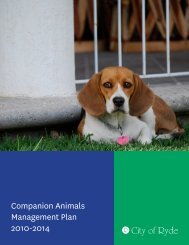Proceedings OF ThE - Australian Institute of Animal Management Inc
Proceedings OF ThE - Australian Institute of Animal Management Inc
Proceedings OF ThE - Australian Institute of Animal Management Inc
Create successful ePaper yourself
Turn your PDF publications into a flip-book with our unique Google optimized e-Paper software.
90 <strong>Proceedings</strong> 2012<br />
AIAM Annual Conference on <strong>Animal</strong> <strong>Management</strong><br />
16<br />
A tiered approach to dealing with inappropriate dog behaviour in NSW<br />
Noel Fuller<br />
Penrith City Council<br />
Often as a result <strong>of</strong> a dog attack on another person<br />
or animal the local authorities are left with the<br />
decision to declare a dog a “Nuisance Dog” or a<br />
“Dangerous Dog”. These control orders can be<br />
unsuitable for the <strong>of</strong>fence and are either too lenient<br />
or too harsh.<br />
Degrees <strong>of</strong> dangerousness can be established on the<br />
basis <strong>of</strong> injury severity in dog attack incidents. These<br />
categories <strong>of</strong> dangerousness include “menacing” or<br />
“threatening” behaviour that does not involve a bite<br />
being inflicted.<br />
By changing the Companion <strong>Animal</strong>s Act 1998 to<br />
include the term “Menacing Dog” and a description<br />
<strong>of</strong> the control orders required, this second tier<br />
to control orders would provide local authorities<br />
with the opportunity to improve the welfare <strong>of</strong><br />
dogs reduce costs to the owner and ensure a safer<br />
community in an effective and timely manner.<br />
Introduction<br />
Early in 1998 the Companion <strong>Animal</strong>s Act 1998 was<br />
introduced into New South Wales and replaced The<br />
Dog Act 1966.<br />
This legislation was developed to capture the ever<br />
changing perceptions <strong>of</strong> the community, to apply best<br />
practice companion animal (dogs & cats) control and<br />
education, and increase the enforcement provisions<br />
for local council their Law Enforcement and <strong>Animal</strong><br />
<strong>Management</strong> <strong>of</strong>ficers.<br />
Since the commencement <strong>of</strong> the Companion <strong>Animal</strong><br />
Act 1998 (referred to as the Act), the Act has been<br />
reviewed approximately every five years. This<br />
review has taken place with advice from selected<br />
experts, local council law enforcement <strong>of</strong>ficers, legal<br />
representation and parliamentary advice.<br />
The reviews looked at adapting the appropriate level<br />
<strong>of</strong> legislation to an ever changing government or<br />
community expectation and closing any loopholes<br />
that may exist in the Act. Changing this legislation<br />
benefits the community and allows the local<br />
authority to enforce the Act with greater expectations<br />
<strong>of</strong> compliance and community confidence.<br />
At times, new bills are introduced to parliament<br />
to strengthen the Act; these bills are driven by<br />
community expectations, media sensationalism or<br />
political gain. The introduction <strong>of</strong> these new bills<br />
has resulted in changes to the Act, which could be<br />
debated as a kneejerk reaction.<br />
This paper will examine the recommendations for a<br />
tiered approach when enforcing control orders on<br />
dogs in the community, provide examples <strong>of</strong> how<br />
these recommendations would benefit local councils,<br />
law enforcement <strong>of</strong>ficers and dog owners, and take<br />
into consideration the welfare <strong>of</strong> the dog.<br />
Current situation<br />
Under the current legislation (the Act) when a dog<br />
attacks a person or another animal, other than<br />
vermin, the local authority has the option <strong>of</strong> applying<br />
a Nuisance Order or a Dangerous Dog Order. This<br />
<strong>of</strong>ten depends on the severity <strong>of</strong> the attack and<br />
provides the local authority with an option to apply<br />
a Nuisance Order that ceases after six months or<br />
declare the dog dangerous which could be in force<br />
for the life <strong>of</strong> the dog and at great expense to the<br />
owner.<br />
Quite <strong>of</strong>ten there could be a case for an order to<br />
be imposed on an owner <strong>of</strong> a dog due to the dog<br />
menacing the area. This type <strong>of</strong> dog falls between<br />
the “nuisance dog” and the “dangerous dog” and<br />
meets similar definition under Section 21 <strong>of</strong> the Act<br />
“Nuisance Dog”.<br />
(1) (d) repeatedly runs at or chases any person, animal<br />
(other than vermin and, in relation to an animal,<br />
otherwise than in the course <strong>of</strong> droving, tending,<br />
working or protecting stock) or vehicle, or<br />
(e) endangers the health <strong>of</strong> any person or animal (other<br />
than vermin and, in relation to an animal, otherwise<br />
than in the course <strong>of</strong> droving, tending, working or<br />
protecting stock), and<br />
Section 33 <strong>of</strong> the Act “Meaning <strong>of</strong> Dangerous”,<br />
(b) has, without provocation, repeatedly threatened to<br />
attack or repeatedly chased a person or animal (other<br />
than vermin), or



